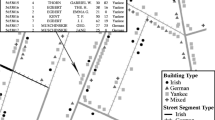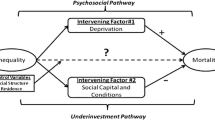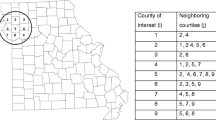Abstract
The infant mortality rate is a fundamental measure of population health used internationally. In the United States, the infant mortality rate is higher than what would be expected for a country of its affluence. We present an analysis of US county infant mortality rates using modern Bayesian spatial statistical methodologies. Our key predictors in our statistical analysis are residential racial and poverty segregation, measured by the dissimilarity, interaction and spatial proximity indexes. We use both Exploratory Spatial Data Analysis methods and Hierarchical Bayesian spatial regression models to examine the influences of these segregation measures on the infant mortality rate for each county, net of income inequality, degree of rurality and relative socioeconomic deprivation. The spatial measures of racial segregation suggest that when blacks live in close proximity to each other, this tends to increase the infant mortality rate. The results for poverty segregation suggest the same pattern, when poor populations live in close proximity to one another this is generally detrimental to the county infant mortality rate. However, interaction between blacks and whites and poor and non-poor residents of an area is protective for infant mortality.




Similar content being viewed by others
References
Acevedo-Garcia, D. (2000). Residential segregation and the epidemiology of infectious diseases. Social Science and Medicine, 51(8), 1143–1161.
Acevedo-Garcia, D., & Lochner, K. A. (2003). Residential segregation and health. In I. Kawachi & L. F. Berkman (Eds.), Neighborhoods and health (pp. 265–287). Oxford: Oxford University Press.
Acevedo-Garcia, D., & Osypuk, T. L. (2008). Invited commentary: Residential segregation and health-the complexity of modeling separate social contexts. American Journal of Epidemiology, 168(11), 1255–1258. doi:10.1093/aje/kwn290.
Arato, N. M., Dryden, I. L., & Taylor, C. C. (2006). Hierarchical Bayesian modelling of spatial age-dependent mortality. Computational Statistics & Data Analysis, 51(2), 1347–1363. doi:10.1016/j.csda.2006.02.007.
Assuncao, R. M., Schmertmann, C. P., Potter, J. E., & Cavenaghi, S. M. (2005). Empirical Bayes estimation of demographic schedules for small areas. Demography, 42(3), 537–558.
Banerjee, S., Carlin, B. P., & Gelfand, A. E. (2004). Hierarchical modeling and analysis of spatial data. Boca Raton, FL: Chapman & Hall/CRC.
Basso, O., & Wilcox, A. J. (2009). Intersecting birth weight-specific mortality curves: Solving the riddle. American Journal of Epidemiology, 169(7), 787–797. doi:10.1093/aje/kwp024.
Bell, J. F., Zimmerman, F. J., Almgren, G. R., Mayer, J. D., & Huebner, C. E. (2006). Birth outcomes among urban African-American women: A multilevel analysis of the role of racial residential segregation. Social Science and Medicine, 63(12), 3030–3045. doi:10.1016/j.socscimed.2006.08.011.
Besag, J. (1974). Spatial interaction and the statistical analysis of lattice systems. Journal of the Royal Statistical Society Series B-Methodological, 36(2), 192–236.
Besag, J., York, J. C., & Mollie, A. (1991). Bayesian image restoration with two applications in spatial statistics. Annals of the Institute of Statistical Mathematics, 43(1), 1–59.
Buka, S. L., Brennan, R. T., Rich-Edwards, J. W., Raudenbush, S. W., & Earls, F. (2003). Neighborhood support and the birth weight of urban infants. American Journal of Epidemiology, 157(1), 1–8.
Cerda, M., Buka, S. L., & Rich-Edwards, J. W. (2008). Neighborhood influences on the association between maternal age and birthweight: A multilevel investigation of age-related disparities in health. Social Science and Medicine, 66(9), 2048–2060. doi:10.1016/j.socscimed.2008.01.027.
Chen, J., Roth, R. E., Naito, A. T., Lengerich, E. J., & MacEachren, A. M. (2008). Geovisual analytics to enhance spatial scan statistic interpretation: an analysis of U.S. cervical cancer mortality. International Journal of Health Geographics, 7, 57.
Collins, J. W., & David, R. J. (2009). Racial disparity in low birth weight and infant mortality. Clinics in Perinatology, 36(1), 63–73. doi:10.1016/j.clp.2008.09.004.
Collins, J. W., & Schulte, N. F. (2003). Infant health: Race, risk, and residence. In I. Kawachi & L. F. Berkman (Eds.), Neighborhoods and health (pp. 223–232). New York: Oxford University Press.
Collins, C. A., & Williams, D. R. (1999). Segregation and mortality: The deadly effects of racism? Sociological Forum, 14(3), 495–523.
Ellen, I. G. (2000). Is segregation bad for your health? The case of low birth weight. In W. G. Gale & J. R. Pack (Eds.), Brookings-Wharton papers on Urban Affairs 2000 (pp. 203–229). Washington, DC: Brookings Institution Press.
Ellen, I. G., Mijanovich, T., & Dillman, K. (2001). Neighborhood effects on health: Exploring the links and assessing the evidence. Journal of Urban Affairs, 23(3–4), 391–408.
Elliott, P., & Wartenberg, D. (2004). Spatial epidemiology: Current approaches and future challenges. Environmental Health Perspectives, 112(9), 998–1006.
Finch, B. K., Lim, N., Perez, W., & Do, D. P. (2007). Toward a population health model of segmented assimilation: The case of low birth weight in Los Angeles. Sociological Perspectives, 50(3), 445–468. doi:10.1525/sop.2007.50.3.445.
Fu, L. Y., Colson, E. R., Corwin, M. J., & Moon, R. Y. (2008). Infant sleep location: Associated maternal and infant characteristics with sudden infant death syndrome prevention recommendations. Journal of Pediatrics, 153(4), 503–508. doi:10.1016/j.jpeds.2008.05.004.
Gelman, A. E. (2006). Prior distributions for variance parameters in hierarchical models. Bayesian Analysis, 1(3), 515–534.
Gelman, A. E., & Rubin, D. (1992). Inference from interative simulatoin using multiple sequences (with discussion). Statistical Science, 7(4), 457–511.
Goza, F. W., Stockwell, E. G., & Balistreri, K. S. (2007). Racial differences in the relationship between infant mortality and socioeconomic status. Journal of Biosocial Science, 39(4), 517–529. doi:10.1017/s0021932006001581.
Grady, S. C. (2006). Racial disparities in low birthweight and the contribution of residential segregation: A multilevel analysis. Social Science and Medicine, 63(12), 3013–3029. doi:10.1016/j.socscimed.2006.08.017.
Grady, S. C., & Ramirez, I. J. (2008). Mediating medical risk factors in the residential segregation and low birthweight relationship by race in New York City. Health & Place, 14(4), 661–677. doi:10.1016/j.healthplace.2007.10.011.
Guest, A. M., Almgren, G., & Hussey, J. M. (1998). The ecology of race and socioeconomic distress: Infant and working age mortality in Chicago. Demography, 35(1), 23–34.
Hearst, M. O., Oakes, J. M., & Johnson, P. J. (2008). The effect of racial residential segregation on black infant mortality. American Journal of Epidemiology, 168(11), 1247–1254. doi:10.1093/aje/kwn291.
Hummer, R. A. (1993). Racial differentials in infant mortality in the U.S.: An examination of social and health determinants. Social Forces, 72(2), 529–554.
Huynh, M., Parker, J. D., Harper, S., Pamuk, E., & Schoendorf, K. C. (2005). Contextual effect of income inequality on birth outcomes. International Journal of Epidemiology, 34(4), 888–895.
Iceland, J., Sharpe, C., & Steinmetz, E. (2005). Class differences in African American residential patterns in US metropolitan areas: 1990–2000. Social Science Research, 34(1), 252–266. doi:10.1016/j.ssresearch.2004.02.001.
Kain, J. F. (1968). Housing segregation, Negro employment, and metropolitan decentralization. Quarterly Journal of Economics, 82(2), 175–197.
Kato, S. K., Vieira, D. D., & Fachel, J. M. G. (2009). Utilization of fully Bayesian modeling to detect patterns in relative risk variation for infant mortality in Rio Grande do Sul State, Brazil. Cadernos De Saude Publica, 25(7), 1501–1510.
Kawachi, I., Kennedy, B. P., & Wilkinson, R. G. (1999). Crime: Social disorganization and relative deprivation. Social Science and Medicine, 48(6), 719–731.
Kramer, M. S., Demissie, K., Yang, H., Platt, R. W., Sauve, R., Liston, R., et al. (2000). The contribution of mild and moderate preterm birth to infant mortality. Journal of the American Medical Association, 284(7), 843–849.
Kramer, M. R., & Hogue, C. R. (2008). Place matters: Variation in the black/white very preterm birth rate across US metropolitan areas, 2002–2004. Public Health Reports, 123(5), 576–585.
Lahr, M. B., Rosenberg, K. D., & Lapidus, J. A. (2007). Maternal-infant bedsharing: Risk factors for bedsharing in a population-based survey of new mothers and implications for SIDS risk reduction. Maternal and Child Health Journal, 11(3), 277–286. doi:10.1007/s10995-006-0166-z.
Laraia, B. A., Messer, L. C., Kaufman, J. S., Dole, N., Caughy, M., O’Campo, P., et al. (2006). Direct observation of neighborhood attributes in an urban area of the US south: characterizing the social context of pregnancy. International Journal of Health Geographics, 5, 1–11.
LaVeist, T. A. (1989). Linking residential segregation to the infant-mortality race disparities in U.S. cities. Sociology and Social Research, 73(2), 90–94.
LaVeist, T. A. (1993). Segregation, poverty, and empowerment: Health consequences for African Americans. Milbank Quarterly, 71(1), 41–64.
Lawson, A. B. (2009). Bayesian disease mapping: Hierarchical modeling in spatial epidemiology. Boca Raton: CRC Press.
Lawson, A. B., Biggeri, A. B., Boehning, D., Lesaffre, E., Viel, J. F., Clark, A., et al. (2000). Disease mapping models: An empirical evaluation. Statistics in Medicine, 19(17–18), 2217–2241.
Lieberson, S., & Carter, D. K. (1982). A model for inferring the voluntary and involuntary causes of residential segregation. Demography, 19(4), 511–526.
Lunn, D., Spiegelhalter, D., Thomas, A., & Best, N. (2009). The BUGS project: Evolution, critique and future directions (with discussion). Statistics in Medicine, 28(25), 3049–3082.
Lunn, D. J., Thomas, A., Best, N., & Spiegelhalter, D. (2000). WinBUGS—a Bayesian modelling framework: Concepts, structure, and extensibility. Statistics and Computing, 10(4), 325–337.
MacDorman, M. F., Callaghan, W. M., Mathews, T. J., Hoyert, D. L., & Kochanek, K. D. (2007). Trends in preterm-related infant mortality by race and ethnicity, United States, 1999–2004. International Journal of Health Services, 37(4), 635–641. doi:10.2190/HS.37.4.c.
Masi, C. M., Hawkley, L. C., Piotrowski, Z. H., & Pickett, K. E. (2007). Neighborhood economic disadvantage, violent crime, group density, and pregnancy outcomes in a diverse, urban population. Social Science and Medicine, 65(12), 2440–2457. doi:10.1016/j.socscimed.2007.07.014.
Mason, S. M., Messer, L. C., Laraia, B. A., & Mendola, P. (2009). Segregation and preterm birth: The effects of neighborhood racial composition in North Carolina. Health & Place, 15(1), 1–9. doi:10.1016/j.healthplace.2008.01.007.
Massey, D. S. (1996). The age of extremes: Concentrated affluence and poverty in the twenty-first century. Demography, 33(4), 395–412.
Massey, D. S., & Denton, N. A. (1988). The dimensions of residential segregation. Social Forces, 67(2), 281–315.
Massey, D. S., & Denton, N. A. (1989). Hypersegregation in U.S. metropolitan areas: Black and Hispanic segregation along five dimensions. Demography, 26(3), 373–391.
Massey, D. S., & Eggers, M. L. (1990). The ecology of inequality: Minorities and the concentration of poverty, 1970–1980. The American Journal of Sociology, 95(5), 1153–1188.
Matthews, S. A., Yang, T. C., Hayslett, K. L., & Ruback, R. B. (2010). Built environment and property crime in Seattle, 1998–2000: A Bayesian analysis. Environment and Planning A, 42(6), 1403–1420. doi:10.1068/a42393.
McLaughlin, D. K., Stokes, C. S., Smith, P. J., & Nonoyama, A. (2007). Differential mortality across the United States: The influence of place-based inequality. In L. M. Lobao, G. Hooks, & A. R. Tickamyer (Eds.), The sociology of spatial inequality (pp. 141–162). Albany: State University of New York Press.
Messer, L. C., Oakes, J. M., & Mason, S. (2010). Effects of socioeconomic and racial residential segregation on preterm birth: A cautionary tale of structural confounding. American Journal of Epidemiology, 171(6), 664–673. doi:10.1093/aje/kwp435.
Morales, L. S., Staiger, D., Horbar, J. D., Carpenter, J., Kenny, M., Geppert, J., et al. (2005). Mortality among very low-birthweight infants in hospitals serving minority populations. American Journal of Public Health, 95(12), 2206–2212. doi:10.2105/ajph.2004.046730.
Moran, P. A. P. (1950). Notes on continuous stochastic phenomena. Biometrika, 37(1/2), 17–23.
Ocana-Riola, R., & Mayoral-Cortes, J. M. (2010). Spatio-temporal trends of mortality in small areas of Southern Spain. BMC Public Health, 10. doi:10.1186/1471-2458-10-26.
Ostfeld, B. M., Perl, H., Esposito, L., Hempstead, K., Hinnen, R., Sandler, A., et al. (2006). Sleep environment, positional, lifestyle, and demographic characteristics associated with bed sharing in sudden infant death syndrome cases: A population-based study. Pediatrics, 118(5), 2051–2059. doi:10.1542/peds.2006-0176.
Pearl, M., Braveman, P., & Abrams, B. (2001). The relationship of neighborhood socioeconomic characteristics to birthweight among 5 ethnic groups in California. American Journal of Public Health, 91(11), 1808–1814.
Pickett, K. E., Collins, J. W., Masi, C. M., & Wilkinson, R. G. (2005). The effects of racial density and income incongruity on pregnancy outcomes. Social Science and Medicine, 60(10), 2229–2238. doi:10.1016/j.socscimed.2004.10.023.
Pickett, K. E., Shaw, R. J., Atkin, K., Kiernan, K. E., & Wilkinson, R. G. (2009). Ethnic density effects on maternal and infant health in the Millennium Cohort Study. Social Science and Medicine, 69(10), 1476–1483. doi:10.1016/j.socscimed.2009.08.031.
Polednak, A. P. (1991). Black-white differences in infant-mortality in 38 standard metropolitan statistical areas. American Journal of Public Health, 81(11), 1480–1482.
Polednak, A. P. (1996). Trends in US urban black infant mortality, by degree of residential segregation. American Journal of Public Health, 86(5), 723–726.
R Development Core Team. (2010). R: A language and environment for statistical computing. (2.11.0 ed.). Vienna, Austria: R Foundation for Statistical Computing.
Reardon, S. F. (2006). A conceptual framework for measuring segregation and its association with population outcomes. In J. M. Oakes & J. S. Kaufman (Eds.), Methods in social epidemiology (pp. 169–192). San Francisco: Jossey-Bass.
Reardon, S. F., & O’Sullivan, D. (2004). Measures of spatial segregation. Sociological Methodology, 34(1), 121–162.
Roberts, E. M. (1997). Neighborhood social environments and the distribution of low birthweight in Chicago. American Journal of Public Health, 87(4), 597–603.
Sartorius, B. K. D., Kahn, K., Vounatsou, P., Collinson, M. A., & Tollman, S. M. (2010). Young and vulnerable: Spatial-temporal trends and risk factors for infant mortality in rural South Africa (Agincourt), 1992–2007—art. no. 645. BMC Public Health, 10, 645.
Schabenberger, O., & Gotway, C. A. (2005). Statistical methods for spatial data analysis. Boca Raton, FL: Chapman and Hall/CRC.
Schempf, A., Strobino, D., & O’Campo, P. (2009). Neighborhood effects on birthweight: An exploration of psychosocial and behavioral pathways in Baltimore, 1995–1996. Social Science and Medicine, 68(1), 100–110. doi:10.1016/j.socscimed.2008.10.006.
Schmertmann, C. P., Potter, J. E., & Cavenaghi, S. M. (2008). Exploratory analysis of spatial patterns in Brazil’s fertility transition. Population Research and Policy Review, 27(1), 1–15. doi:10.1007/S11113-007-9052-7.
Schulz, A., Williams, D. R., Isreal, B. A., & Lempert, L. B. (2002). Racial and spatial relations as fundamental determinants of health in Detroit. Milbank Quarterly, 80(4), 677–707.
Shapiro-Mendoza, C. K., Tomashek, K. M., Kotelchuck, M., Barfield, W., Nannini, A., Weiss, J., et al. (2008). Effect of late-preterm birth and maternal medical conditions on newborn morbidity risk. Pediatrics, 121(2), E223–E232. doi:10.1542/peds.2006-3629.
Shapiro-Mendoza, C. K., Tomashek, K. M., Kotelchuck, M., Barfield, W., Weiss, J., & Evans, S. (2006). Risk factors for neonatal morbidity and mortality among “Healthy,” late preterm newborns. Seminars in Perinatology, 30(2), 54–60. doi:10.1053/j.semperi.2006.02.002.
Shoultz, G., Givens, J., & Drane, J. W. (2007a). Urban form, heart disease, and geography: A case study in composite index formation and bayesian spatial modeling. Population Research and Policy Review, 26(5/6), 661–685. doi:10.1007/s11113-007-9049-2.
Shoultz, G., Givens, J., & Drane, J. W. (2007b). Urban form, heart disease, and geography: A case study in composite index formation and bayesian spatial modeling. Population Research and Policy Review, 26(5–6), 661–685. doi:10.1007/S11113-007-9049-2.
Sims, M., Sims, T. L., & Bruce, M. A. (2007). Urban poverty and infant mortality rate disparities. Journal of the National Medical Association, 99(4), 349–356.
Singh, G. K., & Kogan, M. D. (2007a). Persistent socioeconomic disparities in infant, neonatal, and postneonatal mortality rates in the United States, 1969–2001. Pediatrics, 119(4), E928–E939. doi:10.1542/peds.2005-2181. ISSN0031-4005
Singh, G. K., & Kogan, M. D. (2007b). Widening socioeconomic disparities in US childhood mortality, 1969–2000. American Journal of Public Health, 97(9), 1658–1665. doi:10.2105/ajph.2006.087320.
Slack, T., Singelmann, J., Fontenot, K., Poston, D. L., Saenz, R., & Siordia, C. (2009). Poverty in the Texas borderland and lower Mississippi delta: A comparative analysis of differences by family type. Demographic Research, 20(Jan–June), 353–376.
Sparks, P. J., McLaughlin, D. K., & Stokes, C. S. (2009). Differential neonatal and postneonatal infant mortality rates across US counties: The role of socioeconomic conditions and rurality. Journal of Rural Health, 25(4), 332–341.
Sparks, P. J., & Sparks, C. S. (2010). An application of spatially autoregressive models to the study of US county mortality rates. Population, Space and Place, 16(6), 465–481.
Spiegelhalter, D. J., Best, N., Carlin, B. P., & van der Linde, A. (2002). Bayesian measures of model complexity and fit (with discussion). Journal of the Royal Statistical Society Series B-Methodological, 64(4), 583–639.
VanderWeele, T. J., Lantos, J. D., Siddique, J., & Lauderdale, D. S. (2009). A comparison of four prenatal care indices in birth outcome models: Comparable results for predicting small-for-gestational-age outcome but different results for preterm birth or infant mortality. Journal of Clinical Epidemiology, 62(4), 438–445. doi:10.1016/j.jclinepi.2008.08.001.
Vinikoor, L. C., Kaufman, J. S., MacLehose, R. F., & Laraia, B. A. (2008). Effects of racial density and income incongruity on pregnancy outcomes in less segregated communities. Social Science and Medicine, 66(2), 255–259. doi:10.1016/j.socscimed.2007.08.016.
Voss, P. R., Long, D. D., Hammer, R. B., & Friedman, S. (2006). County child poverty rates in the US: A spatial regression approach. Population Research and Policy Review, 25(4), 369–391. doi:10.1007/S11113-006-9007-4.
Waller, L. A., & Gotway, C. A. (2004). Applied spatial statistics for public health data. New York: Wiley Interscience.
Wilkinson, R. G. (1996). Unhealthy societies: The afflictions of inequality. London: Routledge.
Yang, T. C., Jensen, L., & Haran, M. (2011). Social capital and human mortality: Explaining the rural paradox with county-level mortality data. Rural Sociology, 76(3), 347–374.
Yang, T. C., Teng, H. W., & Haran, M. (2009). The impacts of social capital on infant mortality in the U.S.: A spatial investigation. Applied Spatial Analysis and Policy, 2(3), 211–227.
Author information
Authors and Affiliations
Corresponding author
Rights and permissions
About this article
Cite this article
Johnelle Sparks, P., Sparks, C.S. & Campbell, J.J.A. An application of Bayesian spatial statistical methods to the study of racial and poverty segregation and infant mortality rates in the US. GeoJournal 78, 389–405 (2013). https://doi.org/10.1007/s10708-011-9445-3
Published:
Issue Date:
DOI: https://doi.org/10.1007/s10708-011-9445-3




